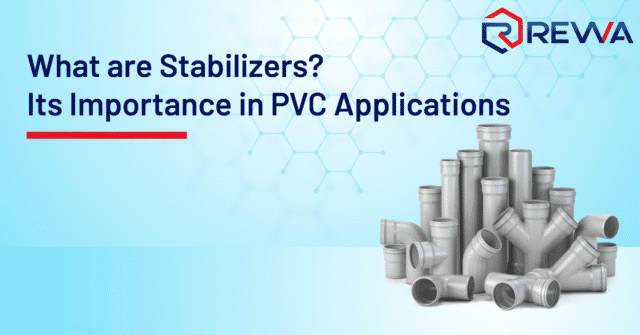
PVC is one of the most versatile and widely used plastics in a variety of industries, including electrical, consumer goods industries, construction and automotive applications such as profiles, pipes, windows, flooring, roofing, and more. PVC enables the manufacturing of contemporary products with extraordinary results by making major contributions to quality, durability, and cost-effectiveness. However, PVC is prone to breakdown under a variety of environmental circumstances. PVC Heat Stabilizers commonly known as Stabilizers are added to PVC resin to prevent or minimize the thermal degradation of PVC during processing or when exposed to high temperatures.
This article aims to provide a basic understanding of PVC STABILIZERS and explore their importance and their Role in PVC Processing.
WHAT ARE STABILIZERS (USED IN PVC)?
PVC is susceptible to degradation when subjected to heat, which can lead to discoloration, loss of mechanical properties, and the release of hydrochloric acid gas. Heat stabilizers are added to PVC formulations to protect the polymer chains from degradation caused by heat and other environmental factors. These stabilizers work by inhibiting the degradation reactions, maintaining the integrity and performance of the PVC compound.
The most commonly used PVC Stabilizers:
- Lead-based Stabilizers (usage reduced due to environmental concerns)
- Calcium-Zinc based Stabilizers
- Tin Stabilizers (e.g., methyl tin, butyl tin, octyl tin)
- Barium-Cadmium Stabilizers (usage reduced due to environmental and health concerns)
- Organic Stabilizers
Role & Importance of Stabilizers in PVC
PVC Stabilizers principal function is to prevent PVC materials from degrading. When PVC is subjected to heat, it can degrade thermally, resulting in discolouration, mechanical strength loss, and lower performance. Stabilizers operate by scavenging and neutralising free radicals produced during the degradation process, preventing further deterioration and preserving the polymer’s integrity.
In addition, Stabilizers help maintain PVC’s chemical resistance, allowing it to endure exposure to acids, bases, and other corrosive compounds. They assist in the preservation of PVC’s molecular structure, ensuring its chemical stability and resistance to chemical reactions. Stabilizers also serve an important role in avoiding the release of harmful compounds from PVC, making them suitable for usage in a variety of sectors such as construction, automotive, electrical, packaging, and healthcare.
Desired Industries for PVC Stabilizer Applications:
- Construction Industry: PVC Stabilizers are crucial additives in the construction industry as they offer thermal stability, UV resistance, and discolouration prevention, assuring the life and integrity of the products such as plumbing pipes and cable profiles.
- Automotive Industry: Stabilizers prevent PVC from degradation caused by heat, oxidation, and chemical exposure, preserving the longevity and aesthetic appeal of the PVC Profiles
- Electrical and Electronics Industry: Stabilizers offer electrical insulation, flame retardancy, and thermal degradation prevention in electric cables, allowing electrical equipment to operate safely and reliably.
- Packaging Industry: Stabilizers improve PVC film heat stability, clarity, and printability, assuring product protection and visual appeal.
- Furniture and Interior Design Industry: The use of Stabilizers in the furniture and interior design industry offer UV resistance, and colour stability, and prevent deterioration in the furniture and interior design industries, assuring the life and aesthetic appeal of these products.
Stabilizers assure that PVC is processable during the production process. They help in the control of viscosity, the prevention of melt deterioration, and the improvement of the flow characteristics of PVC compounds. This allows for fast processing and the manufacturing of complicated PVC profiles with consistency.
Conclusion:
PVC Stabilizers play an important role in various industries that depend on PVC-based products. These Stabilizers improve PVC product’s thermal stability, UV resistance, colour stability, assuring a longer lifespan and durability. To optimize the performance and safety of PVC applications, it is critical to choose suitable Stabilizers according to specific requirements and regulatory concerns. With the use of PVC Stabilizers, businesses can safely process PVC-based products for a wide range of applications while fulfilling the needs of developing technologies and solving environmental challenges by producing durable and sustainable products.
FAQ:
Why are stabilizer used in PVC processing?In PVC manufacturing, stabilizers are used to improve thermal stability, prevent deterioration, and retain the desirable physical and mechanical attributes of PVC products. What are the examples of stabilizer additives?Following are the most commonly used PVC stabilizers additives:
What are the different types of stabilizers?Based on the chemical composition, performance characteristics, and environmental considerations, following are the types of PVC stabilizers.
|

